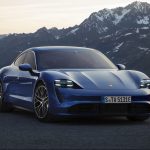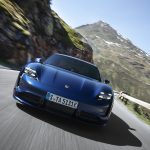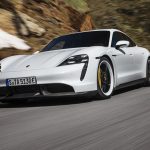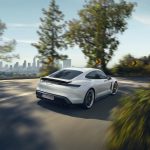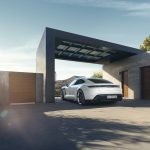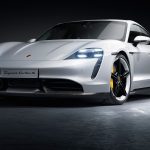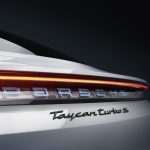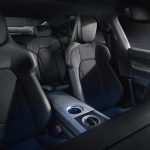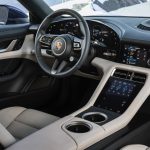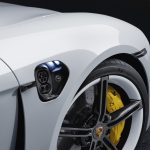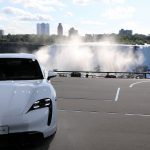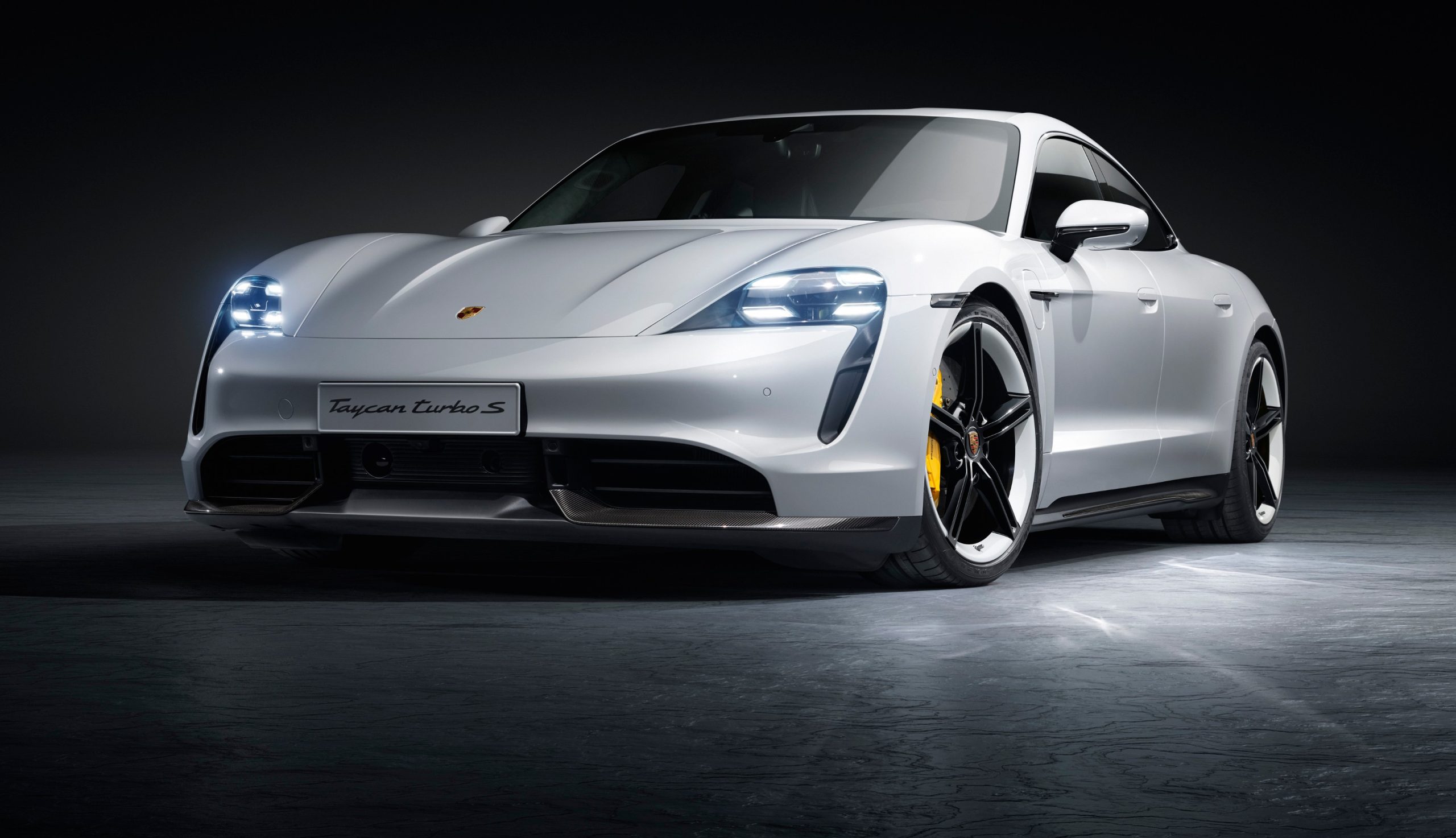
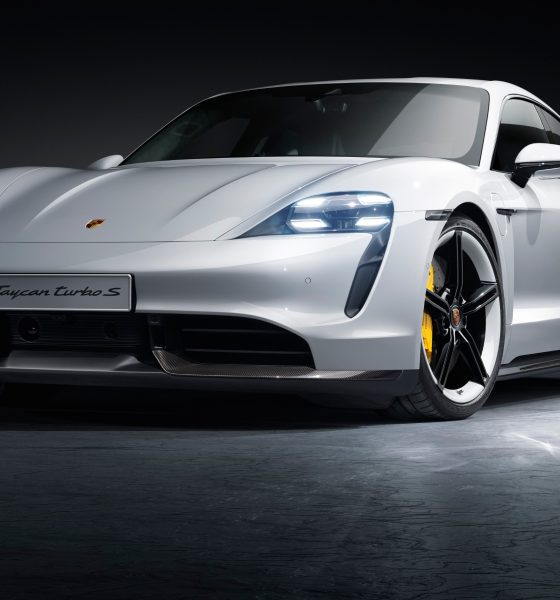
News
Porsche Taycan is here: 0-60 mph in 2.6 sec, 750 HP, good looks with a 911 price tag
The Porsche Taycan is here. In three simultaneous events in Canada, Germany, and China, the veteran automaker took the wraps off its first all-electric sports car. Addressing the audience at Niagara Falls, Porsche Executive Board Member for Sales and Marketing Detlev von Platen highlighted the importance of the Taycan to the company, particularly as it is a vehicle that is designed to carry Porsche into the electric age.
“The Taycan links our heritage to the future. It carries forward the success story of our brand – a brand that has fascinated and thrilled people the world over for more than 70 years. This day marks the start of a new era,” he said.
Porsche will be starting its electric car push with the Taycan’s top two configurations: the Taycan Turbo and the Taycan Turbo S. The base Taycan, as well as the midrange Taycan 4S, are expected to follow later this year, while the vehicle’s first derivative, the outdoor-themed Taycan Cross Turismo, is poised to be launched by the end of 2020. The company noted that by 2022, it would have invested over $6.6 billion in its electric vehicle initiatives.
Following is an overview of the Taycan’s characteristics, from its design and performance to its safety features and price.
- Photography: Christoph Bauer Postproduction: Wagnerchic – www.wagnerchic.com
- Photography: Christoph Bauer Postproduction: Wagnerchic – www.wagnerchic.com
- Photography: Christoph Bauer Postproduction: Wagnerchic – www.wagnerchic.com
- Photography: Christoph Bauer Postproduction: Wagnerchic – www.wagnerchic.com
- Photography: Christoph Bauer Postproduction: Wagnerchic – www.wagnerchic.com
The Porsche Taycan Turbo and the Taycan Turbo S. (Credit: Porsche AG)
Design
Immediately noticeable from the production version of the Taycan is that the vehicle is very close to the appearance of the Mission E sedan. The Taycan is 1,966 mm (77.4 inches) wide but only 1,380 mm (54.33 inches) high, which gives the car a wide and flat look that is distinctly Porsche. It’s very low to the ground, being 40 mm (1.5 inches) lower than the Panamera. From the rear, the Taycan is shaped by a roofline that slopes downward to the rear, while its side sections are highly sculpted, giving the vehicle a wide and sporty stance. Overall, the Taycan has a length of 4,963 mm (195.39 inches) and a wheelbase of 2,900 mm (114.17 inches). The vehicle also has a 0.22 drag coefficient, which is currently the lowest of all cars Porsche has released to date.
Performance
Porsche has only revealed the performance figures of the Taycan Turbo and Turbo S. With Launch Control, the Taycan Turbo S is capable of going from 0 to 60 mph in 2.6 seconds. The Taycan Turbo is only a fraction of a second behind, with its 0-60 mph time of 3.0 seconds. Quarter-mile times for each vehicle stand at 10.8 seconds for the Taycan Turbo S and 11.1 seconds for the Taycan Turbo.
The secret to the Taycan’s speed lies in its two electric motors, the front of which has a max output of 190 kW for the Turbo S and 175 kW for the Turbo. The Taycan’s 335 kW rear motor, as well as its dedicated Launch Mode options with “Overboost,” ultimately allows the Taycan to have a maximum torque of 1,050 Nm for the Turbo S and 850 Nm for the Turbo variant.
- Photography: Christoph Bauer Postproduction: Wagnerchic – www.wagnerchic.com
- The Porsche Taycan Turbo S. (Credit: Christoph Bauer Postproduction: Wagnerchic – www.wagnerchic.com)
- Photography: Christoph Bauer Postproduction: Wagnerchic – www.wagnerchic.com
- (Credit: Porsche AG)
The Porsche Taycan Turbo and the Taycan Turbo S. (Credit: Porsche AG)
Safety
The Taycan’s body is comprised of an aluminum chassis reinforced with hot-formed steel on pillars and doors. Porsche highlighted that the vehicle was designed with strict requirements to ensure that nothing can puncture the car’s battery pack. In the event of a frontal crash, the Taycan’s front assemblies slide away from the pack to prevent intrusions into the cabin. The Taycan is equipped with a suite of sensors as well, including front and rear radar, wide-angle cameras, a mono front camera, ultrasonic sensors, and long-range radar.
Battery
Porsche opted to utilize a 100 kWh battery pack with the Taycan, though only 93 kWh of this is usable. The Taycan’s batteries are made from Li-ion pouch cells that are provided by LG Chem. The Taycan’s aluminum battery pack has a 2 mm thickness on the bottom, with cell modules resting on top of the cooling system on the battery pack.
The automaker utilized its 800-volt architecture for the Taycan, which, Porsche noted, reduces the current needed to produce large amounts of power. The lower current also means that Porsche could use thinner cables for the vehicle, allowing the Taycan’s wiring system to be lighter. Ultimately, Porsche notes that the Taycan’s 800-volt tech enables higher continuous power and faster charging.
- Photography: Christoph Bauer Postproduction: Wagnerchic – www.wagnerchic.com
- The Porsche Taycan unveiled. (Photo: Sean Mitchell/Teslarati)
The Porsche Taycan Turbo and the Taycan Turbo S. (Credit: Porsche AG)
Range
The Porsche Taycan has not been issued with an official EPA rating yet, though the Turbo S has been given a 388–412 km (241-256 miles) range per charge under the WLTP standard. The Taycan Turbo was given a higher max range rating by the WLTP, outlasting its more powerful sibling with an estimated range of 381-450 km (236.74-279.61 miles) per charge.
The Taycan Turbo has a power consumption of 25.7–24.5 kWh/100 km under the WLTP, which makes it more efficient compared to the Taycan Turbo S’ 26.7–23.0 kWh/100 km. Overall, the Taycan Turbo has a combined power consumption rating of 26.0 kWh/100 km under the NEDC, while the Turbo S variant is rated at 26.9 kWh/100 km.
Features
The Porsche Taycan’s storage area is comprised of a rear trunk and a frunk. According to the vehicle’s official spec sheet released for North America, the Taycan’s frunk has 2.8 cubic feet of space, while its rear trunk has 12.9 cubic feet of space. The Taycan is also equipped with two charging ports. Interestingly, the Taycan has a nifty feature for times when its charging port door is stuck due to ice. In such instances, the Taycan’s charge port door will vibrate and gradually increase the force until the vibrations break the ice. This should help electric car owners charge their vehicles during winters.
Price
Porsche states that the Taycan is one of its most important vehicles since the 911. In this sense, the Taycan is priced in pretty much the same bracket as the flagship sports car. The Taycan Turbo starts at $150,900 ($153,310 at launch), which is comparable to the price of a 2019 Porsche 911 Turbo. For comparison, Porsche Fremont’s official website lists the 2019 911 Turbo with an MSRP of $161,800.
The Taycan Turbo S is Porsche’s flagship electric car to date, and it is priced as such. The vehicle starts at $185,000 ($187,610 at launch), making it comparable to the price of a 2019 Porsche 911 Turbo S, which is listed in the United States with an MSRP of $190,700.
Watch the Porsche Taycan’s unveiling in the video below.

Elon Musk
Starlink passes 9 million active customers just weeks after hitting 8 million
The milestone highlights the accelerating growth of Starlink, which has now been adding over 20,000 new users per day.

SpaceX’s Starlink satellite internet service has continued its rapid global expansion, surpassing 9 million active customers just weeks after crossing the 8 million mark.
The milestone highlights the accelerating growth of Starlink, which has now been adding over 20,000 new users per day.
9 million customers
In a post on X, SpaceX stated that Starlink now serves over 9 million active users across 155 countries, territories, and markets. The company reached 8 million customers in early November, meaning it added roughly 1 million subscribers in under seven weeks, or about 21,275 new users on average per day.
“Starlink is connecting more than 9M active customers with high-speed internet across 155 countries, territories, and many other markets,” Starlink wrote in a post on its official X account. SpaceX President Gwynne Shotwell also celebrated the milestone on X. “A huge thank you to all of our customers and congrats to the Starlink team for such an incredible product,” she wrote.
That growth rate reflects both rising demand for broadband in underserved regions and Starlink’s expanding satellite constellation, which now includes more than 9,000 low-Earth-orbit satellites designed to deliver high-speed, low-latency internet worldwide.
Starlink’s momentum
Starlink’s momentum has been building up. SpaceX reported 4.6 million Starlink customers in December 2024, followed by 7 million by August 2025, and 8 million customers in November. Independent data also suggests Starlink usage is rising sharply, with Cloudflare reporting that global web traffic from Starlink users more than doubled in 2025, as noted in an Insider report.
Starlink’s momentum is increasingly tied to SpaceX’s broader financial outlook. Elon Musk has said the satellite network is “by far” the company’s largest revenue driver, and reports suggest SpaceX may be positioning itself for an initial public offering as soon as next year, with valuations estimated as high as $1.5 trillion. Musk has also suggested in the past that Starlink could have its own IPO in the future.
News
NVIDIA Director of Robotics: Tesla FSD v14 is the first AI to pass the “Physical Turing Test”
After testing FSD v14, Fan stated that his experience with FSD felt magical at first, but it soon started to feel like a routine.

NVIDIA Director of Robotics Jim Fan has praised Tesla’s Full Self-Driving (Supervised) v14 as the first AI to pass what he described as a “Physical Turing Test.”
After testing FSD v14, Fan stated that his experience with FSD felt magical at first, but it soon started to feel like a routine. And just like smartphones today, removing it now would “actively hurt.”
Jim Fan’s hands-on FSD v14 impressions
Fan, a leading researcher in embodied AI who is currently solving Physical AI at NVIDIA and spearheading the company’s Project GR00T initiative, noted that he actually was late to the Tesla game. He was, however, one of the first to try out FSD v14.
“I was very late to own a Tesla but among the earliest to try out FSD v14. It’s perhaps the first time I experience an AI that passes the Physical Turing Test: after a long day at work, you press a button, lay back, and couldn’t tell if a neural net or a human drove you home,” Fan wrote in a post on X.
Fan added: “Despite knowing exactly how robot learning works, I still find it magical watching the steering wheel turn by itself. First it feels surreal, next it becomes routine. Then, like the smartphone, taking it away actively hurts. This is how humanity gets rewired and glued to god-like technologies.”
The Physical Turing Test
The original Turing Test was conceived by Alan Turing in 1950, and it was aimed at determining if a machine could exhibit behavior that is equivalent to or indistinguishable from a human. By focusing on text-based conversations, the original Turing Test set a high bar for natural language processing and machine learning.
This test has been passed by today’s large language models. However, the capability to converse in a humanlike manner is a completely different challenge from performing real-world problem-solving or physical interactions. Thus, Fan introduced the Physical Turing Test, which challenges AI systems to demonstrate intelligence through physical actions.
Based on Fan’s comments, Tesla has demonstrated these intelligent physical actions with FSD v14. Elon Musk agreed with the NVIDIA executive, stating in a post on X that with FSD v14, “you can sense the sentience maturing.” Musk also praised Tesla AI, calling it the best “real-world AI” today.
News
Tesla AI team burns the Christmas midnight oil by releasing FSD v14.2.2.1
The update was released just a day after FSD v14.2.2 started rolling out to customers.

Tesla is burning the midnight oil this Christmas, with the Tesla AI team quietly rolling out Full Self-Driving (Supervised) v14.2.2.1 just a day after FSD v14.2.2 started rolling out to customers.
Tesla owner shares insights on FSD v14.2.2.1
Longtime Tesla owner and FSD tester @BLKMDL3 shared some insights following several drives with FSD v14.2.2.1 in rainy Los Angeles conditions with standing water and faded lane lines. He reported zero steering hesitation or stutter, confident lane changes, and maneuvers executed with precision that evoked the performance of Tesla’s driverless Robotaxis in Austin.
Parking performance impressed, with most spots nailed perfectly, including tight, sharp turns, in single attempts without shaky steering. One minor offset happened only due to another vehicle that was parked over the line, which FSD accommodated by a few extra inches. In rain that typically erases road markings, FSD visualized lanes and turn lines better than humans, positioning itself flawlessly when entering new streets as well.
“Took it up a dark, wet, and twisty canyon road up and down the hill tonight and it went very well as to be expected. Stayed centered in the lane, kept speed well and gives a confidence inspiring steering feel where it handles these curvy roads better than the majority of human drivers,” the Tesla owner wrote in a post on X.
Tesla’s FSD v14.2.2 update
Just a day before FSD v14.2.2.1’s release, Tesla rolled out FSD v14.2.2, which was focused on smoother real-world performance, better obstacle awareness, and precise end-of-trip routing. According to the update’s release notes, FSD v14.2.2 upgrades the vision encoder neural network with higher resolution features, enhancing detection of emergency vehicles, road obstacles, and human gestures.
New Arrival Options also allowed users to select preferred drop-off styles, such as Parking Lot, Street, Driveway, Parking Garage, or Curbside, with the navigation pin automatically adjusting to the ideal spot. Other refinements include pulling over for emergency vehicles, real-time vision-based detours for blocked roads, improved gate and debris handling, and Speed Profiles for customized driving styles.

